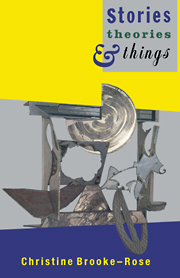Book contents
- Frontmatter
- Contents
- Preface
- Acknowledgements
- Part I Theories as stories
- Part II Stories and style
- Part III Theories of stories
- 10 Fiction, figment, feign
- 11 Which way did they go? Thataways
- 12 Palimpsest history
- 13 Illusions of parody
- 14 Illusions of anti-realism
- 15 A womb of one's own?
- Part IV Things?
- References
- Index
15 - A womb of one's own?
Published online by Cambridge University Press: 20 August 2009
- Frontmatter
- Contents
- Preface
- Acknowledgements
- Part I Theories as stories
- Part II Stories and style
- Part III Theories of stories
- 10 Fiction, figment, feign
- 11 Which way did they go? Thataways
- 12 Palimpsest history
- 13 Illusions of parody
- 14 Illusions of anti-realism
- 15 A womb of one's own?
- Part IV Things?
- References
- Index
Summary
As a useful transition to the next section, which deals with women and women's writing in general, I would like to continue in the thrust of the last chapter with a brief consideration of women in ‘postmodernism’, where similar problems arise, but are sometimes made worse by some of the feminists themselves.
Women and the ‘avant-garde’
In a perceptive article entitled ‘Male Signature, Female Aesthetic: The Gender Politics of Experimental Writing’ (Friedman & Fuchs 1988, 72–81), Marianne DeKoven confronts the problem of women's experimental fiction head on. She notes that manifestos for avantgarde and feminist stylistic practice ‘often sound remarkably alike without knowing that they do or taking cognizance of one another in any way’. Already in ‘For the Etruscans’ (1980), Rachel Blau Duplessis and members of ‘Workshop 9’ had noted that ‘any list of the characteristics of postmodernism would at the same time be a list of the traits of women's writing’ (151, quoted DeKoven 73). The few recognitions of affinities are all formulated by women and, moreover, feminist critics like Kristeva and Cixous have both defined écriture féminine as an eruption of the feminine pre-Oedipal, or presymbolic (which Kristeva calls ‘the semiotic’) into avant-garde masculine writing, from Mallarmé, Lautréamont to Joyce and Artaud for Kristeva (1980, 165), or, for Cixous, Genet, one of the ‘rare exceptions’ to the rule that ‘there has not yet been any writing that inscribes femininity’ (1976, 98, quoted DeKoven 72). In other words, écriture féminineIS the male avant-garde.
- Type
- Chapter
- Information
- Stories, Theories and Things , pp. 223 - 234Publisher: Cambridge University PressPrint publication year: 1991

